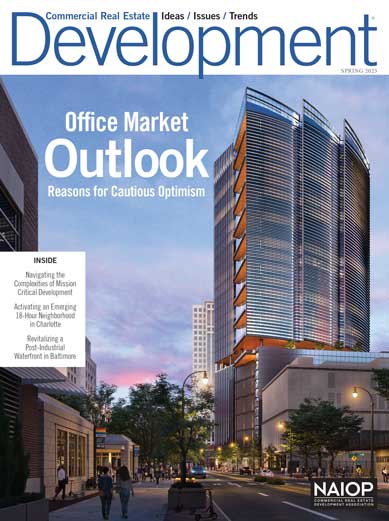Supply chain advances and new technologies are affecting how, where and what types of industrial facilities are being built.
Spring 2018 Issue
Capitol View: Master Planning a Dynamic Urban District
By: Kyle ReisA cohesive yet flexible master plan sets the stage for this Nashville mixed-use development, which is now underway on a brownfield site.
Crossroads Commerce Park: From Blighted Brownfield to Thriving Infill Industrial Park
By: Bill Mosher and Ann SperlingLong-term planning and collaboration among various partners across multiple jurisdictions have been key to creating a new industrial park in Denver’s Globeville neighborhood.
Best Practices in Developing Skilled Nursing Facilities
By: Greg LazaroffAn Ohio-based developer of these specialized properties describes how it is capitalizing on growing opportunities as well as evolving market trends.
Must-Read Articles

How to Set Up a Private Equity Real Estate Fund

Repurposing Common Spaces in Office Buildings

Three Ways High-resolution Aerial Imagery Facilitates Due Diligence

Columbus Tackles Smart City Initiatives
RELATED RESEARCH AND PUBLICATIONS
Office Space Demand Forecast, Fourth Quarter 2025
From Static to Strategic: AI’s Role in Next-Generation Industrial Real Estate
- Report,
- Technology,
- ...
Industrial Space Demand Forecast, Third Quarter 2025
PERSPECTIVES
Sound Bites from The Office Conference 2017
Getting to Know the Chairman
Meet the Visionaries
CEO on Leadership: Robert Ward, President and CEO, Skanska USA Commercial Development
ADDITIONAL ARTICLES
Bringing It Home: Four Innovative Concepts for E-commerce Deliveries to Consumers
All of these innovations could affect how goods are delivered directly to consumers in the future.
What Lies Ahead for Commercial Real Estate Sectors
Women-centric Coworking Spaces
Virtual Credentialing Is Now a Reality
Treehouses at Microsoft
New & Noteworthy Projects
ARCHIVED ISSUES
View All Archived Issues Summer 2025 Issue
Summer 2025 Issue
Development’s summer 2025 issue explores experiential retail and the brick-and-mortar resurgence. Also featured: a modern warehouse campus in Toronto that honors its manufacturing heritage; a coalition of Oregon real estate organizations working to revitalize downtown Portland; and the creative capital stack strategy behind a mixed-use project in West Baltimore.
 Spring 2025 Issue
Spring 2025 Issue
The spring 2025 issue offers insights about where the office market might be heading over the coming year, explores the complexities of mission critical development, and provides detailed looks at two transformative mixed-use projects: The Bowl at Ballantyne in Charlotte and Baltimore Peninsula in Maryland.
 Winter 2024/2025 Issue
Winter 2024/2025 Issue
Development magazine’s winter issue delves into the evolving uses of artificial intelligence in the commercial real estate industry, from lease management and building operations to portfolio assessment and data analysis.







